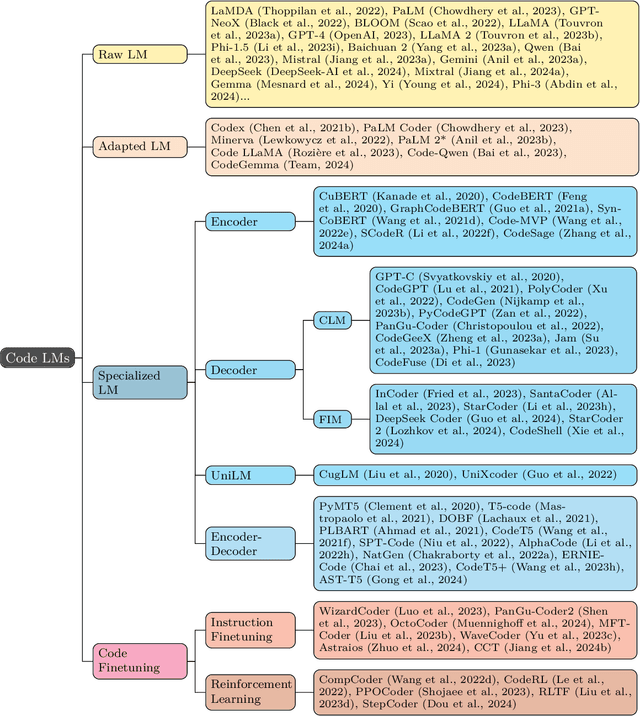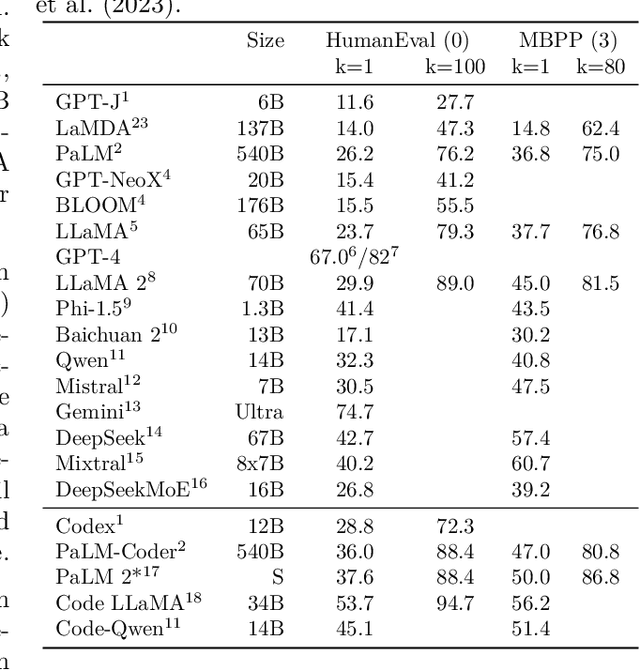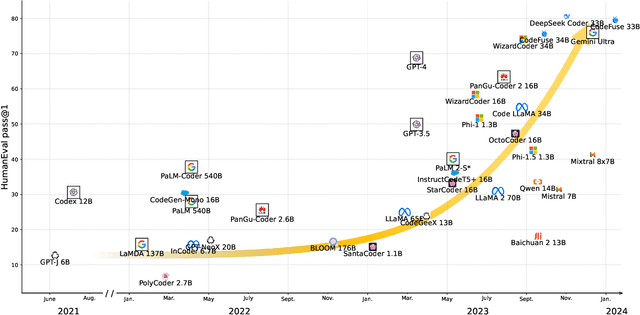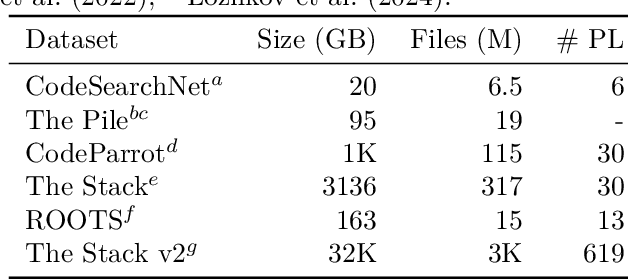Ziyin Zhang
F2LLM Technical Report: Matching SOTA Embedding Performance with 6 Million Open-Source Data
Oct 02, 2025Abstract:We introduce F2LLM - Foundation to Feature Large Language Models, a suite of state-of-the-art embedding models in three sizes: 0.6B, 1.7B, and 4B. Unlike previous top-ranking embedding models that require massive contrastive pretraining, sophisticated training pipelines, and costly synthetic training data, F2LLM is directly finetuned from foundation models on 6 million query-document-negative tuples curated from open-source, non-synthetic datasets, striking a strong balance between training cost, model size, and embedding performance. On the MTEB English leaderboard, F2LLM-4B ranks 2nd among models with approximately 4B parameters and 7th overall, while F2LLM-1.7B ranks 1st among models in the 1B-2B size range. To facilitate future research in the field, we release the models, training dataset, and code, positioning F2LLM as a strong, reproducible, and budget-friendly baseline for future works.
DeepTheorem: Advancing LLM Reasoning for Theorem Proving Through Natural Language and Reinforcement Learning
May 29, 2025Abstract:Theorem proving serves as a major testbed for evaluating complex reasoning abilities in large language models (LLMs). However, traditional automated theorem proving (ATP) approaches rely heavily on formal proof systems that poorly align with LLMs' strength derived from informal, natural language knowledge acquired during pre-training. In this work, we propose DeepTheorem, a comprehensive informal theorem-proving framework exploiting natural language to enhance LLM mathematical reasoning. DeepTheorem includes a large-scale benchmark dataset consisting of 121K high-quality IMO-level informal theorems and proofs spanning diverse mathematical domains, rigorously annotated for correctness, difficulty, and topic categories, accompanied by systematically constructed verifiable theorem variants. We devise a novel reinforcement learning strategy (RL-Zero) explicitly tailored to informal theorem proving, leveraging the verified theorem variants to incentivize robust mathematical inference. Additionally, we propose comprehensive outcome and process evaluation metrics examining proof correctness and the quality of reasoning steps. Extensive experimental analyses demonstrate DeepTheorem significantly improves LLM theorem-proving performance compared to existing datasets and supervised fine-tuning protocols, achieving state-of-the-art accuracy and reasoning quality. Our findings highlight DeepTheorem's potential to fundamentally advance automated informal theorem proving and mathematical exploration.
Code Graph Model (CGM): A Graph-Integrated Large Language Model for Repository-Level Software Engineering Tasks
May 22, 2025Abstract:Recent advances in Large Language Models (LLMs) have shown promise in function-level code generation, yet repository-level software engineering tasks remain challenging. Current solutions predominantly rely on proprietary LLM agents, which introduce unpredictability and limit accessibility, raising concerns about data privacy and model customization. This paper investigates whether open-source LLMs can effectively address repository-level tasks without requiring agent-based approaches. We demonstrate this is possible by enabling LLMs to comprehend functions and files within codebases through their semantic information and structural dependencies. To this end, we introduce Code Graph Models (CGMs), which integrate repository code graph structures into the LLM's attention mechanism and map node attributes to the LLM's input space using a specialized adapter. When combined with an agentless graph RAG framework, our approach achieves a 43.00% resolution rate on the SWE-bench Lite benchmark using the open-source Qwen2.5-72B model. This performance ranks first among open weight models, second among methods with open-source systems, and eighth overall, surpassing the previous best open-source model-based method by 12.33%.
Draft Model Knows When to Stop: A Self-Verification Length Policy for Speculative Decoding
Nov 27, 2024Abstract:Speculative Decoding (SD) has become an important technique in accelerating the inference speed of large language models. Conventional SD methods employ a fixed draft length, which ignores the token generation difficulty across tasks. Consequently, in this paper, we address such an issue and introduce SVIP - a difficulty-aware dynamic draft length policy for speculative decoding systems. Based on a theoretical lower bound of draft token acceptance rate and its inference-time approximation, SVIP adaptively determines the lengths of draft sequences based on the entropy of each draft token distribution. Experimental results on mainstream SD benchmarks and frameworks demonstrate the superior performance of SVIP, achieving up to 20\% walltime speedup on SpecBench over baseline SD methods and 60\% speedup on MT-Bench for long-form generation of up to 8K tokens. Moreover, SVIP is totally training-free and compatible with any existing SD methods that generate draft tokens autoregressively. Experimental results also show that SVIP yields consistent walltime improvement on top of GliDe & CaPE and EAGLE-2.
GALLa: Graph Aligned Large Language Models for Improved Source Code Understanding
Sep 06, 2024Abstract:Programming languages possess rich semantic information such as data flow that is represented by graphs and not available from the surface form of source code. Recent code language models have scaled to billions of parameters, but model source code solely as text tokens while ignoring any other structural information. Conversely, models that do encode structural information of code make modifications to the Transformer architecture, limiting their scale and compatibility with pretrained LLMs. In this work, we take the best of both worlds with GALLa - Graph Aligned Large Language Model. GALLa utilizes graph neural networks and cross-modal alignment technologies to inject the structural information of code into LLMs as an auxiliary task during finetuning. This framework is both model-agnostic and task-agnostic, as it can be applied to any code LLM for any code downstream task, and requires the structural graph data only at training time from a corpus unrelated to the finetuning data, while incurring no cost at inference time over the baseline LLM. Experiments on five code tasks with four different baseline LLMs ranging in size from 350M to 8B validate the effectiveness of GALLa, demonstrating consistent improvement over the baseline, even for powerful models such as LLaMA3.
Multiple-Choice Questions are Efficient and Robust LLM Evaluators
May 21, 2024



Abstract:We present GSM-MC and MATH-MC, two multiple-choice (MC) datasets constructed by collecting answers and incorrect predictions on GSM8K and MATH from over 50 open-source models. Through extensive experiments, we show that LLMs' performance on the MC versions of these two popular benchmarks is strongly correlated with their performance on the original versions, and is quite robust to distractor choices and option orders, while the evaluation time is reduced by a factor of up to 30. Following a similar procedure, we also introduce PythonIO, a new program output prediction MC dataset constructed from two other popular LLM evaluation benchmarks HumanEval and MBPP. Our data and code are available at https://github.com/Geralt-Targaryen/MC-Evaluation.
Is Cognition and Action Consistent or Not: Investigating Large Language Model's Personality
Feb 22, 2024Abstract:In this study, we investigate the reliability of Large Language Models (LLMs) in professing human-like personality traits through responses to personality questionnaires. Our goal is to evaluate the consistency between LLMs' professed personality inclinations and their actual "behavior", examining the extent to which these models can emulate human-like personality patterns. Through a comprehensive analysis of LLM outputs against established human benchmarks, we seek to understand the cognition-action divergence in LLMs and propose hypotheses for the observed results based on psychological theories and metrics.
Can ChatGPT Rival Neural Machine Translation? A Comparative Study
Jan 10, 2024Abstract:Inspired by the increasing interest in leveraging large language models for translation, this paper evaluates the capabilities of large language models (LLMs) represented by ChatGPT in comparison to the mainstream neural machine translation (NMT) engines in translating Chinese diplomatic texts into English. Specifically, we examine the translation quality of ChatGPT and NMT engines as measured by four automated metrics and human evaluation based on an error-typology and six analytic rubrics. Our findings show that automated metrics yield similar results for ChatGPT under different prompts and NMT systems, while human annotators tend to assign noticeably higher scores to ChatGPT when it is provided an example or contextual information about the translation task. Pairwise correlation between automated metrics and dimensions of human evaluation produces weak and non-significant results, suggesting the divergence between the two methods of translation quality assessment. These findings provide valuable insights into the potential of ChatGPT as a capable machine translator, and the influence of prompt engineering on its performance.
Distinguishing Translations by Human, NMT, and ChatGPT: A Linguistic and Statistical Approach
Dec 17, 2023



Abstract:The growing popularity of neural machine translation (NMT) and LLMs represented by ChatGPT underscores the need for a deeper understanding of their distinct characteristics and relationships. Such understanding is crucial for language professionals and researchers to make informed decisions and tactful use of these cutting-edge translation technology, but remains underexplored. This study aims to fill this gap by investigating three key questions: (1) the distinguishability of ChatGPT-generated translations from NMT and human translation (HT), (2) the linguistic characteristics of each translation type, and (3) the degree of resemblance between ChatGPT-produced translations and HT or NMT. To achieve these objectives, we employ statistical testing, machine learning algorithms, and multidimensional analysis (MDA) to analyze Spokesperson's Remarks and their translations. After extracting a wide range of linguistic features, supervised classifiers demonstrate high accuracy in distinguishing the three translation types, whereas unsupervised clustering techniques do not yield satisfactory results. Another major finding is that ChatGPT-produced translations exhibit greater similarity with NMT than HT in most MDA dimensions, which is further corroborated by distance computing and visualization. These novel insights shed light on the interrelationships among the three translation types and have implications for the future advancements of NMT and generative AI.
A Survey on Language Models for Code
Nov 19, 2023



Abstract:In this work we systematically review the recent advancements in code processing with language models, covering 50+ models, 30+ evaluation tasks, 150+ datasets, and 550 related works. We break down code processing models into general language models represented by the GPT family and specialized models that are specifically pretrained on code, often with tailored objectives. We discuss the relations and differences between these models, and highlight the historical transition of code modeling from statistical models and RNNs to pretrained Transformers and LLMs, which is exactly the same course that had been taken by NLP. We also discuss code-specific features such as AST, CFG, and unit tests, along with their application in training code language models, and identify key challenges and potential future directions in this domain. We keep the survey open and updated on GitHub repository at https://github.com/codefuse-ai/Awesome-Code-LLM.
 Add to Chrome
Add to Chrome Add to Firefox
Add to Firefox Add to Edge
Add to Edge